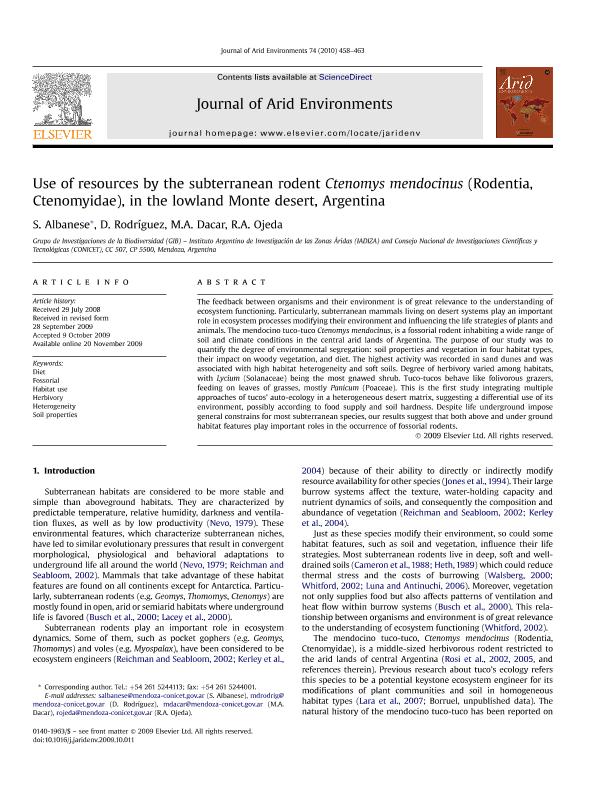Artículo
Use of resources by the subterranean rodent Ctenomys mendocinus (Rodentia, Ctenomyidae), in the lowland Monte desert, Argentina
Fecha de publicación:
04/2010
Editorial:
Academic Press Ltd - Elsevier Science Ltd
Revista:
Journal of Arid Environments
ISSN:
0140-1963
Idioma:
Inglés
Tipo de recurso:
Artículo publicado
Clasificación temática:
Resumen
The feedback between organisms and their environment is of great relevance to the understanding of ecosystem functioning. Particularly, subterranean mammals living on desert systems play an important role in ecosystem processes modifying their environment and influencing the life strategies of plants and animals. The mendocino tuco-tuco Ctenomys mendocinus, is a fossorial rodent inhabiting a wide range of soil and climate conditions in the central arid lands of Argentina. The purpose of our study was to quantify the degree of environmental segregation: soil properties and vegetation in four habitat types, their impact on woody vegetation, and diet. The highest activity was recorded in sand dunes and was associated with high habitat heterogeneity and soft soils. Degree of herbivory varied among habitats, with Lycium (Solanaceae) being the most gnawed shrub. Tuco-tucos behave like folivorous grazers, feeding on leaves of grasses, mostly Panicum (Poaceae). This is the first study integrating multiple approaches of tucos' auto-ecology in a heterogeneous desert matrix, suggesting a differential use of its environment, possibly according to food supply and soil hardness. Despite life underground impose general constrains for most subterranean species, our results suggest that both above and under ground habitat features play important roles in the occurrence of fossorial rodents.
Palabras clave:
Diet
,
Fossorial
,
Habitat Use
,
Herbivory
,
Heterogeneity
,
Soil Properties
Archivos asociados
Licencia
Identificadores
Colecciones
Articulos(IADIZA)
Articulos de INST. ARG DE INVEST. DE LAS ZONAS ARIDAS
Articulos de INST. ARG DE INVEST. DE LAS ZONAS ARIDAS
Citación
Albanese, María Soledad; Rodriguez, Maria Daniela; Dacar, María Ana; Ojeda, Ricardo Alberto; Use of resources by the subterranean rodent Ctenomys mendocinus (Rodentia, Ctenomyidae), in the lowland Monte desert, Argentina; Academic Press Ltd - Elsevier Science Ltd; Journal of Arid Environments; 74; 4; 4-2010; 458-463
Compartir
Altmétricas




